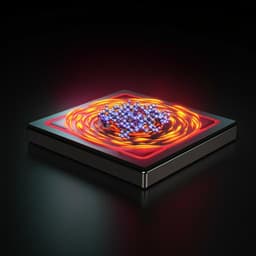
Medicine and Health
Deposition chamber technology as building blocks for a standardized brain-on-chip framework
B. G. C. Maisonneuve, L. Libralesso, et al.
Discover a groundbreaking microfluidic device that transforms *in vitro* brain modeling, spearheaded by researchers B. G. C. Maisonneuve and colleagues, enhancing our understanding of the human central nervous system and neurodegenerative diseases.
~3 min • Beginner • English
Introduction
Neurological disorders such as Alzheimer and Parkinson diseases increasingly affect people aged 60 years and older. Despite substantial research efforts, curative therapies remain elusive, and the reliance on largely palliative treatments imposes a heavy societal cost. Two major bottlenecks hinder progress: (i) the extreme complexity of the human brain—with hundreds of regions, diverse cell types, and unresolved connectivity patterns—making it difficult to relate structure to function and to identify reliable biomarkers; and (ii) limited structural and functional translationality of current in vivo models for preclinical trials, resulting in poor success rates in clinical translation.
Organ-on-a-chip (OoC) microfluidic technologies have enabled progress by compartmentalizing neuronal populations, controlling connectivity and directionality, and coculturing distinct neural cell types with fluidic isolation. These approaches model minimal in vitro versions of in vivo circuits composed of connected nodes. However, most efforts have focused on inter-node connectivity rather than on the inner architecture of nodes. Current methods lack full control over independent, yet connected, organized nodes, which is necessary for physiologically relevant brain-on-chip models.
In this study, the authors present a scalable microfluidic approach to uniformly seed neurons with targeted cell numbers within each node. The method maintains uniform surface coverage across plating chambers over a wide range of neuronal quantities and integrates with existing strategies for controlling inter-node connectivity. This enables construction of multinode neurofluidic chips with defined structural connectivity patterns, potentially modeling CNS circuits relevant to neurodegenerative diseases (e.g., basal ganglia loop implicated in Parkinson disease) and, when combined with human iPSC-derived neurons, offering a minimalist yet relevant disease model.
Literature Review
Methodology
Device concept and architecture: The authors introduce Three Dimensional Deposition Chambers (DCs), supplemental compartments aligned with active areas (e.g., microchannel openings) to control the number and distribution of seeded cells. Two DCs are connected by 450 µm-long microchannels that retain somata while allowing neurites to extend into the adjacent chamber. Inlet and outlet plating channels are built on an upper level relative to the DCs to prevent cells in these channels from connecting to DC-seeded neurons.
Flow generation without pumps: Flow is driven by hydrostatic pressure differences between inlet and outlet reservoirs, avoiding external pumping systems. The flow depends on the height difference of the free surfaces and the hydrodynamic resistance of the channels and DC.
Chamber sizing and target cell numbers: The number of neurons that deposit scales with the DC bottom surface area. An example rectangular DC has Lch = 5000 µm, Wch = 2200 µm, and Hch = 550 µm. The geometry can also be cylindrical; in that case, the chamber diameter replaces Lch in calculations.
Flow velocity tuning relative to settling: To ensure homogeneous deposition, the mean flow velocity in the DC (Vch) is matched to the neuronal settling velocity (Vsedi) such that cells settle at the chamber bottom just before reaching the exit. The optimal condition is given by (Vch − Vsedi)·Hch / Lch = 1 (Eq. 1). The neuronal settling velocity is estimated at ~2 µm/s via Stokes terminal velocity for a ~6 µm diameter cell with density ~2% higher than the suspending fluid.
Hydrodynamic resistance and head losses: Major head losses (viscous pressure drops) at low Reynolds number are estimated by Δz = λ η Q L / (W H^3 ρ g) (Eq. 2), where W, H, L are channel dimensions; Q is flow rate; ρ fluid density; η viscosity; g gravitational acceleration; and Δz the free-surface height difference. The friction factor λ at low Re is approximated by λ = 12(1 − (6/π)(H/W))^−1 (Eq. 3). Minor losses due to geometric changes are neglected for the flow rates used.
Channel and reservoir dimensions: For the example in Fig. 1e, the inlet channel has Win = 1000 µm, Hin = 100 µm, Lin = 1000 µm (to reduce settling there), while the outlet has Wout = 1000 µm, Hout = 50 µm, Lout ≈ 9900 µm, tuned to achieve the target Vch. Inlet and outlet reservoirs are cylinders with Din = Dout = 4 mm. An infused cell suspension volume of 20 µL is used in this example.
Modeling deposition kinetics: A simplified model assumes: (i) fully laminar Poiseuille flow (Re < 1); (ii) Newtonian fluid with flow set by hydrostatic pressure difference and device hydraulic resistance; (iii) a perfectly unicellular monolayer at maximum hexagonal close packing upon full coverage. The fractional surface coverage φ is defined as φ = N π a^2 / (S 3√2) (Eq. 4), where N is the number of deposited neurons, a the neuron radius, and S the DC bottom surface area. With neuron concentration ρ and volume V of suspension that has passed through the DC, N = ρ·V (Eq. 5), and V = Q·t (Eq. 6), where Q is flow rate and t time. For short durations, hydrostatic pressure differences can be treated quasi-constant; otherwise, time discretization accounts for reservoir level changes.
Experimental flow visualization and coverage assessment: Fluid renewal within cylindrical DCs is assessed by exchanging fluorescein and rhodamine 6G and tracking intensity over time (e.g., images at 0, 30, 60 s). Intensity-time curves are reported for infused volumes of 4 µL, 40 µL, and 80 µL (panels b–d). Neuronal surface coverage over time is quantified for various inlet volumes (e.g., 5 µL, 10 µL, 20 µL) and compared with model predictions. Spatial homogeneity is evaluated by dividing the chamber into four quadrants and tracking coverage evolution in each.
Key Findings
- The proposed microfluidic architecture introduces Three Dimensional Deposition Chambers (DCs) that enable controlled and uniform deposition of neuronal populations within nodes of variable size and shape, addressing a key limitation of current in vitro brain models.
- By tuning hydrodynamic resistance and flow relative to neuronal settling, the number of neurons seeded per node can be tailored from approximately 10^3 up to 10^6 while maintaining uniform surface coverage.
- The system operates without external pumps, using hydrostatic pressure differences and dimensioned inlet/outlet channels to set flow. Example dimensions achieving target flow include: inlet channel 1000 µm (W) × 100 µm (H) × 1000 µm (L); outlet channel 1000 µm (W) × 50 µm (H) × ~9900 µm (L); DC example 5000 µm (L) × 2200 µm (W) × 550 µm (H); reservoirs 4 mm diameter; infused volume (example) 20 µL.
- Neuronal settling velocity is estimated at ~2 µm/s (Stokes regime), and Reynolds number is < 1, supporting laminar Poiseuille flow assumptions.
- Flow visualization with fluorescein and rhodamine 6G demonstrates effective fluid exchange within DCs over tens of seconds; intensity-time profiles are reported for infused volumes of 4 µL, 40 µL, and 80 µL.
- Quantitative deposition experiments show time-dependent increases in surface coverage that agree with a simplified model; datasets include inlet volumes of 5 µL, 10 µL, and 20 µL. Spatial analysis across four chamber quadrants indicates uniform coverage when flow is tuned to balance advection and settling.
Discussion
The work addresses a central challenge in brain-on-chip models: achieving physiologically relevant nodes with controlled cell numbers and uniform density. By matching flow velocity to cell settling within tailored DC geometries, the platform ensures that cells deposit evenly across the node before exiting, optimizing the probability of neurite entry into connecting microchannels and maximizing inter-node connectivity efficiency. The standardized hydrodynamic design and operating principles enable reproducible scaling of node size and cell number without pumps, facilitating complex multinode architectures with defined structural connectivity patterns. Such control is foundational for investigating structure–function relationships in neural circuits and for constructing disease-relevant models (e.g., basal ganglia loops pertinent to Parkinson disease).
Conclusion
The study introduces a standardized deposition chamber technology that enables pump-free, uniform, and quantitatively controlled seeding of neurons in neurofluidic devices. Through principled hydrodynamic design and simple operational parameters (reservoir level differences and channel geometries), the platform scales node sizes and cell numbers from thousands to millions while preserving homogeneity. Integrated with established microchannel-based connectivity control, this provides building blocks for complex, organized brain-on-chip networks suited to mechanistic studies and preclinical applications. Future work includes coupling the architecture with human iPSC-derived neurons to create minimalist yet relevant disease models (e.g., for Parkinson disease), extending validation across diverse cell types, and refining models to incorporate more detailed fluid-structure and multiphase interactions.
Limitations
- Minor head losses due to geometric alterations are neglected in device dimensioning for the flow rates used, which may introduce small discrepancies under different operating conditions.
- The deposition model employs simplifying assumptions: fully laminar Poiseuille flow (Re < 1), Newtonian fluid behavior, quasi-constant hydrostatic pressure over short times, and a perfectly unicellular monolayer at maximum hexagonal close packing upon full coverage. These assumptions simplify analysis but may limit predictive accuracy under conditions deviating from these ideals.
- Optimal uniformity depends on precise tuning of flow velocity relative to cellular settling; excessively high or low velocities can lead to cell loss through the outlet or premature, nonuniform deposition, respectively.
Related Publications
Explore these studies to deepen your understanding of the subject.







